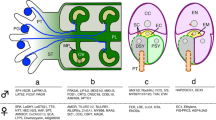Abstract
In flowering plants, the egg cell is generally accompanied by two symmetrical cells, called synergid cells. As early as the 1870s, synergid cells were distinguished from egg cells and cooperation between synergid and egg cells was proposed; the term "synergid" is derived from the Greek "synergos," which means "working together." The accumulation of morphological and genetic data, and, more recently, the in vitro physiological analysis of the fertilization system of Torenia fournieri, have revealed that synergid cells work together with egg and central cells to accomplish double fertilization. This cooperation is of crucial importance in the attraction and acceptance of the pollen tube. In this review article, I focus on the physiological function and behavior of the synergid cell during the fertilization process.
Similar content being viewed by others
Author information
Authors and Affiliations
Additional information
Received: December 20, 2001 / Accepted: December 27, 2001
Rights and permissions
About this article
Cite this article
Higashiyama, T. The synergid cell: attractor and acceptor of the pollen tube for double fertilization. J Plant Res 115, 0149–0160 (2002). https://doi.org/10.1007/s102650200020
Issue Date:
DOI: https://doi.org/10.1007/s102650200020




